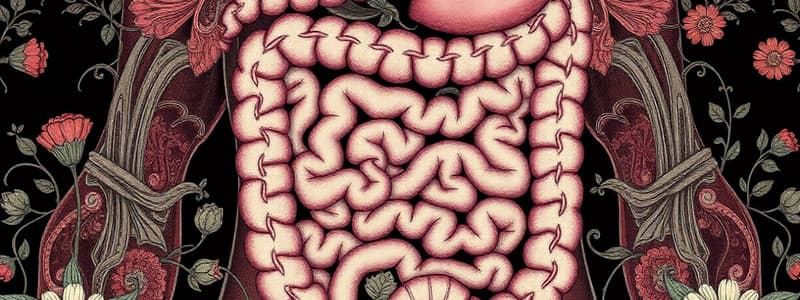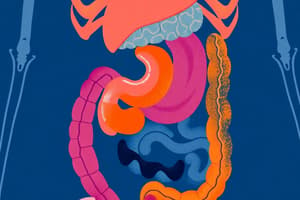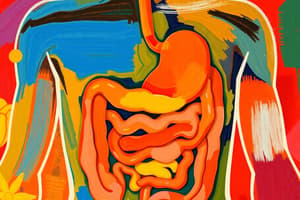Podcast
Questions and Answers
What is the primary function of saliva in the oral cavity?
What is the primary function of saliva in the oral cavity?
- To absorb nutrients from food
- To initiate protein digestion
- To lubricate food and begin carbohydrate digestion (correct)
- To protect the mouth from infection
Which part of the gastrointestinal tract is responsible for most chemical digestion?
Which part of the gastrointestinal tract is responsible for most chemical digestion?
- Oesophagus
- Duodenum (correct)
- Jejunum
- Ileum
What process helps move food down the oesophagus?
What process helps move food down the oesophagus?
- Mastication
- Absorption
- Segmentation
- Peristalsis (correct)
Which type of cell in the small intestine is primarily responsible for nutrient absorption?
Which type of cell in the small intestine is primarily responsible for nutrient absorption?
Which statement about the pharynx is correct?
Which statement about the pharynx is correct?
What is the final section of the small intestine called?
What is the final section of the small intestine called?
How does the small intestine protect itself from infection?
How does the small intestine protect itself from infection?
Which function does the oesophagus NOT perform?
Which function does the oesophagus NOT perform?
What is the primary function of the large intestine?
What is the primary function of the large intestine?
Which type of cell in the large intestine is responsible for reabsorbing water and electrolytes?
Which type of cell in the large intestine is responsible for reabsorbing water and electrolytes?
Which of the following hormones do enteroendocrine cells release?
Which of the following hormones do enteroendocrine cells release?
What does the pancreas do in the digestive process?
What does the pancreas do in the digestive process?
How is bile released into the duodenum?
How is bile released into the duodenum?
What primarily occurs during carbohydrate absorption in the small intestine?
What primarily occurs during carbohydrate absorption in the small intestine?
What is the role of goblet cells in the large intestine?
What is the role of goblet cells in the large intestine?
What happens to fatty acids in the small intestine after absorption?
What happens to fatty acids in the small intestine after absorption?
What is the primary function of leptin in the body?
What is the primary function of leptin in the body?
Which vitamins are classified as fat-soluble vitamins?
Which vitamins are classified as fat-soluble vitamins?
What triggers the gastric phase of digestion?
What triggers the gastric phase of digestion?
What does Basal Metabolic Rate (BMR) represent?
What does Basal Metabolic Rate (BMR) represent?
Which hormone is released in response to acidic chyme entering the small intestine?
Which hormone is released in response to acidic chyme entering the small intestine?
Which of the following accurately defines a calorie?
Which of the following accurately defines a calorie?
What role does cholecystokinin (CCK) play in digestion?
What role does cholecystokinin (CCK) play in digestion?
Which phase of digestion is characterized by the brain signaling the stomach to produce gastric juices?
Which phase of digestion is characterized by the brain signaling the stomach to produce gastric juices?
How is Body Mass Index (BMI) calculated?
How is Body Mass Index (BMI) calculated?
What is the main function of gastrin in the digestive process?
What is the main function of gastrin in the digestive process?
Which BMI classification indicates a person is considered obese?
Which BMI classification indicates a person is considered obese?
Which statement about calories in the body is correct?
Which statement about calories in the body is correct?
How are minerals absorbed in the digestive system?
How are minerals absorbed in the digestive system?
What happens to BMR as a person ages?
What happens to BMR as a person ages?
Which of the following methods can be used to increase BMR?
Which of the following methods can be used to increase BMR?
What physiological functions does BMR support?
What physiological functions does BMR support?
Flashcards
Digestion
Digestion
The process of breaking down food into smaller molecules that can be absorbed by the body.
Peristalsis
Peristalsis
The mechanism by which food is moved through the digestive tract.
Duodenum
Duodenum
The first part of the small intestine where most chemical digestion occurs.
Jejunum
Jejunum
Signup and view all the flashcards
Ileum
Ileum
Signup and view all the flashcards
Enterocytes
Enterocytes
Signup and view all the flashcards
Goblet Cells
Goblet Cells
Signup and view all the flashcards
Paneth Cells
Paneth Cells
Signup and view all the flashcards
Colonocytes
Colonocytes
Signup and view all the flashcards
Large Intestine Function
Large Intestine Function
Signup and view all the flashcards
Pancreas Function
Pancreas Function
Signup and view all the flashcards
Bile Function
Bile Function
Signup and view all the flashcards
Carbohydrate Absorption
Carbohydrate Absorption
Signup and view all the flashcards
Protein Absorption
Protein Absorption
Signup and view all the flashcards
Fat Absorption
Fat Absorption
Signup and view all the flashcards
Fat-Soluble Vitamins
Fat-Soluble Vitamins
Signup and view all the flashcards
Water-Soluble Vitamins
Water-Soluble Vitamins
Signup and view all the flashcards
Minerals
Minerals
Signup and view all the flashcards
Cephalic Phase of Digestion
Cephalic Phase of Digestion
Signup and view all the flashcards
Gastric Phase of Digestion
Gastric Phase of Digestion
Signup and view all the flashcards
Intestinal Phase of Digestion
Intestinal Phase of Digestion
Signup and view all the flashcards
Leptin
Leptin
Signup and view all the flashcards
Ghrelin
Ghrelin
Signup and view all the flashcards
What is Basal Metabolic Rate (BMR)?
What is Basal Metabolic Rate (BMR)?
Signup and view all the flashcards
What is a calorie?
What is a calorie?
Signup and view all the flashcards
What is Body Mass Index (BMI)?
What is Body Mass Index (BMI)?
Signup and view all the flashcards
What is a healthy body mass index (BMI)?
What is a healthy body mass index (BMI)?
Signup and view all the flashcards
Define underweight BMI.
Define underweight BMI.
Signup and view all the flashcards
Define overweight BMI.
Define overweight BMI.
Signup and view all the flashcards
Define obese BMI.
Define obese BMI.
Signup and view all the flashcards
What is digestion?
What is digestion?
Signup and view all the flashcards
Study Notes
The Digestive System
- The digestive system breaks down food, absorbs nutrients, and eliminates waste.
- The gastrointestinal (GI) tract is a continuous tube, extending from the mouth to the anus.
Components of the GI Tract
-
Oral Cavity (Mouth):
- Mechanical digestion begins with chewing (mastication).
- Chemical digestion starts with saliva (containing amylase to break down starch).
- Saliva lubricates food, aiding in digestion.
-
Pharynx:
- Pathway for food from the mouth to the oesophagus.
- Plays a role in respiration, directing air to the larynx.
-
Oesophagus:
- Connects the pharynx to the stomach.
- Peristalsis (coordinated muscle contractions) moves food to the stomach.
-
Peristalsis:
- Rhythmic contractions of smooth muscles in the GI tract.
- Propels food through the digestive system.
-
Small Intestine:
- Divided into three parts: duodenum, jejunum, and ileum.
- Duodenum: Main site for chemical digestion, receiving bile and enzymes.
- Jejunum: Absorbs nutrients.
- Ileum: Absorbs remaining nutrients and bile acids.
-
Differentiated Cells: various specialized cells in the intestines have specific functions (e.g., Enterocytes absorb nutrients).
Accessory Organs of Digestion
-
Pancreas:
- Produces digestive enzymes (amylase, lipase, and proteases), aiding in digestion of carbs, fats, and proteins.
- Secretes bicarbonate to neutralize stomach acid.
-
Liver:
- Produces bile, essential for fat emulsification and digestion.
- Plays a vital role in metabolism, detoxification, and nutrient storage.
-
Gallbladder:
- Stores bile produced by the liver.
- Releases bile into the duodenum in response to fats in food.
The Process of Absorption
- Absorption mainly occurs in the small intestine.
- Nutrients pass through the intestinal wall into the bloodstream or lymphatic system.
- Carbohydrate Absorption: Simple sugars are absorbed directly into the bloodstream.
- Protein Absorption: Amino acids and small peptides are absorbed via active transport.
- Fat Absorption: Fatty acids and monoglycerides are absorbed, reassembled into triglycerides, and transported to the lymphatic system.
- Vitamins and Minerals: Fat-soluble (A, D, E, K) absorbed with fats; water-soluble (B, C) and minerals absorbed through different mechanisms.
Phases of Digestion
- Cephalic Phase: Digestive system preparation triggered by sight, smell, taste of food, stimulating gastric juice production and salivation.
- Gastric Phase: Initiated by food entering the stomach, with stomach expansion stimulating gastric juices to further digest proteins and fats.
- Intestinal Phase: Chyme entering the small intestine triggers hormones that slow gastric emptying further stimulating digestive enzyme and bile release.
Hormones Involved in Digestion
- Leptin: Regulates appetite and energy expenditure.
- Ghrelin: Stimulates appetite.
- Gastrin: Promotes gastric acid production.
- Secretin: Neutralizes stomach acid and stimulates bicarbonate release.
- Cholecystokinin (CCK): Stimulates release of bile and pancreatic enzymes.
Basal Metabolic Rate (BMR) and Body Mass Index (BMI)
- BMR: Energy expenditure at rest.
- BMI: Measure of body fat based on height and weight (kg/m²).
Studying That Suits You
Use AI to generate personalized quizzes and flashcards to suit your learning preferences.




